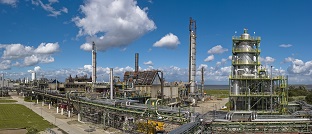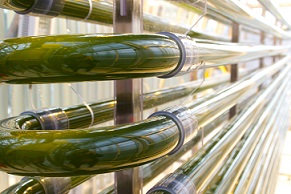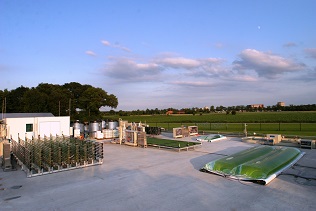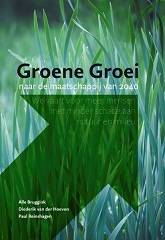How will Europe, the Netherlands in particular, earn its income in twenty-five years’ time, in a sustainable way? How do we prepare for the world of 2040? By green growth, based on the development of sustainable products and services. An analysis of the plans of the major Dutch industrial branches show that they have that in mind.

In 2013, Dutch industries have laid down their vision of the future in the R&D plans of the ‘top sectors’. These documents shows clearly: industry envisages to keep abreast of the international competition by concentrating on sustainability. Meaning primarily: getting better results with less inputs. More and better tomatoes using less water and less insecticides. Better plastics using less energy and less feedstock. In short, green growth. But remarkably, the energy sector is not in this league, it shows little ambition in this field.
Innovative sectors
Agriculture and horticulture. Strong innovative sector in the Netherlands, very good knowledge position based on Wageningen UR. Much potential for yield improvement (already very high relative to other countries), and for improvement of environmental and food quality. Many export opportunities, not just of agricultural products, more importantly also of agricultural services and devices. Europe has the ability to develop into the prime food supplier of the world.
Water. Dutch industries, knowledge institutes and engineering firms are in the top league in all sectors: water management and water quality, construction of specialised ships, harbours. Strong knowledge basis.

Chemicals and materials. Relative to other countries, chemical industry in the Netherlands is very large and innovative. Scientific knowledge and practical skills are very well developed. Chemical industry is on the brink of a major step towards sustainability: towards much lower use of energy and resources, less danger to people living close by, and much less waste. Dutch science excels particularly in the key area of industrial catalysis.
Energy. In this field, Dutch ambitions for better sustainability are quite moderate. For other countries like the US and China, energy problems are much more urgent. The Netherlands does have a strong knowledge position in solar and wind technologies, so far insufficiently used for the build-up of national industries.
High-tech. The Netherlands, particularly in the Eindhoven area, is in the top league. Nanotechnology and materials research are among the focal points. Companies like Philips and ASML play an important role. Innovative chains have developed with a good balance between big companies and many innovative SMEs. Important applications are in fields like health and water.
Creative industry. This sector grows rapidly and becomes more important and productive. The major area of future development is better cooperation with incumbent sectors like health, the food industry and town planning. There is much potential in this area.
Agriculture leads green growth
Technological development is very fast in all sectors. Invariably in the direction of sustainability. In many areas, improvements by a factor 10 are not unrealistic as a goal. For instance, in water and energy use. Improvements by a factor 10 are essential to accommodate the effects of a growing world population attaining a level of wealth comparable to ours at present. Here, need and potential go hand in hand.

Agriculture (including horticulture) is the key sector. In Asia (harbouring a fast growing middle class), policy makers judge the food problem to be at least as important as the climate problem. Europe can play a major role here. Our highly productive and environmentally increasingly benign agricultural techniques may help to feed all mouths in the world. We could sell our knowledge and skills abroad and earn a living in doing so. A much more productive agriculture would require less land for food production; in this way we could put a halt to the destruction of natural areas, and even create more of them.
Much potential in the biobased economy
For green growth, a closer cooperation between agriculture and the chemical industry is equally important. Sustainable chemical industries will increasingly use biobased feedstock (agricultural products and side streams) in a biobased economy. This biobased feedstock is particularly suited for benign chemical reactions with little environmental side effects. Excellent biobased resources are vegetal oils, sugars, starch, cellulose, vegetal proteins and vegetal specialties (e.g. for medicines and cosmetics). The variety of potential products is very large.
The use of biobased feedstock for materials and chemicals will not endanger food supply. Because world demand for materials and chemicals is much smaller than agricultural production. Quite different from the use of biomass for energy production, because demand for energy carriers exceeds the level of agricultural production. An increasing use of biomass for energy and biofuels would therefore lead to further destruction of natural areas and to occasional conflicts with food supply. Contrary to the effects of using biomass for materials and chemicals. Europe, with its high agricultural yields, would be in an excellent position for the supply of biobased feedstock to industry. Like sugar from the sugar beet. The liberalisation of the European sugar market in 2017 will be quite important to both sugar producers and sustainable chemical industries.
 Opposition and a new consciousness
Opposition and a new consciousness
Green growth, like many innovations, runs into opposition and resistance to change. Everyone cherishes innovation, but often the majority of public innovation funds is awarded to major companies – not always the most important innovators. Policy measures (like the liberalisation of public services) sometimes stand in the way of innovation. Or the absence of such policy measures (like a CO2 levy). And the social climate has increasingly become dominated by mistrust and the blind pursuit of self-interest that are at odds with innovation.
But fortunately, there are social trends that support green growth. Many initiatives surface in society, based on mutual trust. Social media can assist in building coherence in such groups. And there are signs of a new regional consciousness together with regional sustainable economic growth. Sustainability is on the way of becoming an accepted social goal. And technology development appears to become beneficial to such developments.
Towards sustainable regions
This all points in the direction of the advent of sustainable regions and small-scale circular economies. Carrying new opportunities, like regional energy supply in local cooperatives, better use of regional resources, and a growing consciousness among consumers and citizens. People will develop new forms of cooperation, and women are increasingly playing a decisive role in that development. Internet may supply solutions to problems that we now tend to look upon as insurmountable, like the cost of health care. Technology will increasingly become helpful to the solution of social problems. Education might prepare us for that. There are reasons to have faith in the future.
This is an abstract of the book Groene Groei, Naar de maatschappij van 2040 (in Dutch), by Alle Bruggink, Diederik van der Hoeven and Paul Reinshagen. Edited by Biobased Press, Amsterdam 2014. ISBN 978-90-822760-0-8.
